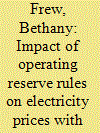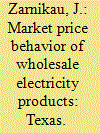|
|
|
Sort Order |
|
|
|
Items / Page
|
|
|
|
|
|
|
| Srl | Item |
| 1 |
ID:
179685


|
|
|
|
|
| Summary/Abstract |
In competitive wholesale electricity markets, significant effort is devoted to designing markets that set efficient prices for maintaining supply-demand balance. One factor that can impact prices is administratively-set scarcity pricing, which sets prices to a preset level when the market is not able to meet operating reserve or energy requirements. When energy and operating reserves are co-optimized, assumptions surrounding operating reserve requirements and scarcity pricing can impact system-wide price outcomes for both operating reserves and energy. This study uses production cost modeling of an ERCOT-like system to evaluate the impact of operating reserve eligibility, scarcity pricing, and quantity rules on electricity prices, and therefore also on generator revenues. Results reveal economic and operational benefits with allowing open participation in reserve markets, as this enables greater access to the full set of capable resources at lowest cost. Furthermore, both energy and reserve prices are strongly impacted by reserve scarcity pricing events, which reveals that reserve scarcity pricing assumptions can impact price outcomes even for units not providing reserves. This study highlights the importance of operating reserve scarcity pricing rules because of the strong coupling between energy and reserve prices and because these rules serve as proxies for true price responsive demand.
|
|
|
|
|
|
|
|
|
|
|
|
|
|
|
|
| 2 |
ID:
162941


|
|
|
|
|
| Summary/Abstract |
Applying a regression-based approach to a newly developed sample of over 60,000 hourly observations for 01/01/2011–12/30/2017, we answer the question: what moves the day-ahead market (DAM) prices for energy and ancillary services (AS) and the real-time market (RTM) price for energy in the Electric Reliability Council of Texas (ERCOT)? Our answer comprises the following findings that capture the interdependence of ERCOT's energy and AS products: (1) the DAM energy price increases with the day-ahead forecasts of natural gas price, system load and AS requirements but declines with nuclear and wind generation's forecasts; (2) the AS prices increase with the DAM energy price and the AS procurement forecasts but decline with the AS offer forecasts; and (3) the RTM energy price increases with the DAM energy price but diverges from the DAM energy price due to forecasting errors related to the DAM energy price's fundamental drivers. These findings imply that Texas can reduce the prices for day-ahead energy, day-ahead AS and real-time energy via wind generation development and demand-side-management. Further, Texas can improve its electricity trading efficiency by improving ERCOT's forecast accuracy to narrow the RTM energy price's divergence from the DAM energy price.
|
|
|
|
|
|
|
|
|
|
|
|
|
|
|
|
| 3 |
ID:
171379


|
|
|
|
|
| Summary/Abstract |
Faced with reserve margin projections well below the adopted target of 13.75% of the system peak forecast, the Public Utility Commission of Texas on 01/17/2019 ordered the state's grid operator, the Electric Reliability Council of Texas, to “right shift” the operating reserve demand curve (ORDC) to increase generators' revenue from energy sales in ERCOT's real-time market (RTM). Using a large sample of 15-min data for the backcast period of 01/01/2015 through 12/31/2018, we calculate the ORDC shift's impact on RTM prices and investment incentives for natural-gas-fired generation (NGFG). Had the ORDC shift been in effect in the backcast period, the resulting RTM price increases in 2018 could suffice to justify NGFG investment, though not in the prior years of 2015, 2016 and 2017. While the actual ORDC shift occurred on 03/01/2019 had a large impact on RTM prices in the ensuing six-month period of March–August 2019, Texas's planned renewable generation is expected to erode NGFG's operating profit, thus diminishing the ORDC's investment incentive over time. Hence, Texas's energy-only market design will likely need further refinements to solve the missing money problem of inadequate NGFG investment incentive.
|
|
|
|
|
|
|
|
|
|
|
|
|
|
|
|
| 4 |
ID:
105812


|
|
|
|
|
| Publication |
2011.
|
| Summary/Abstract |
The extant literature on wind generation and wholesale electricity spot prices says little about how wind generation may affect any price differences between two inter-connected sub-markets. Using extensive data from the four ERCOT zones of Texas, this paper develops a two-stage model to attack the issue. The first stage is an ordered-logit regression to identify and quantify, for example, the impact of wind generation in the West zone on the estimated probability of a positive or negative price difference between the North and West zones. The second stage is a log-linear regression model that identifies and quantifies the estimated impact of wind generation on the sizes of those positive and negative price differences. It is shown that high wind generation and low load in the wind-rich ERCOT West zone tend to lead to congestion and zonal price differences, that those differences are time-dependent, and that other factors such as movements in nuclear generation and natural-gas prices, as well as fluctuating non-West zone loads, also play a role. The results have broad implications for energy policy makers that extend well beyond the borders of Texas and, indeed, those of the United States.
|
|
|
|
|
|
|
|
|
|
|
|
|
|
|
|
|
|
|
|
|